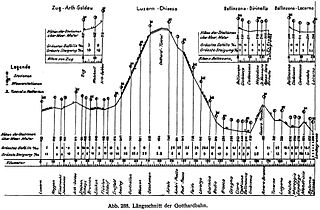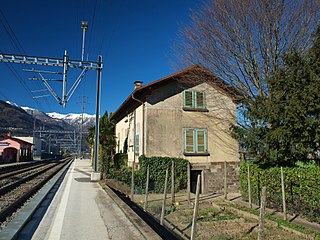Related Research Articles

Ticino, sometimes Tessin, officially the Republic and Canton of Ticino or less formally the Canton of Ticino, is one of the 26 cantons forming the Swiss Confederation. It is composed of eight districts and its capital city is Bellinzona. It is also traditionally divided into the Sopraceneri and the Sottoceneri, respectively north and south of Monte Ceneri. Red and blue are the colours of its flag.

Lugano is a city and municipality in Switzerland, part of the Lugano District in the canton of Ticino. It is the largest city of both Ticino and the Italian-speaking southern Switzerland. Lugano has a population of 62,315, and an urban agglomeration of over 150,000. It is the ninth largest Swiss city.

There are 106 municipalities in the canton of Ticino, Switzerland,. Municipalities (comuni) are grouped in circles (circoli) which are part of districts (distretti).

Bellinzona is a municipality, a historic Swiss town, and the capital of the canton of Ticino in Switzerland. The town is famous for its three castles that have been UNESCO World Heritage Sites since 2000.
The Ticinese dialect is the set of dialects, belonging to the Alpine and Western branch of the Lombard language, spoken in the northern part of the Canton of Ticino (Sopraceneri); the dialects of the region can generally vary from valley to valley, often even between single localities, while retaining the mutual intelligibility that is typical of the Lombard linguistic continuum.

Lugano was the name of a canton of the Helvetic Republic from 1798 to 1803, with its capital at Lugano. The canton unified the former Landvogteien of Lugano, Mendrisio, Locarno and Valmaggia.

The Gotthard railway is the Swiss trans-alpine railway line from northern Switzerland to the canton of Ticino. The line forms a major part of an important international railway link between northern and southern Europe, especially on the Rotterdam-Basel-Genoa corridor. The Gotthard Railway Company was the former private railway company which financed the construction of, and originally operated, that line.

Giubiasco is a former municipality in the district of Bellinzona in the canton of Ticino in Switzerland.

Monte Ceneri is a mountain pass in the canton of Ticino in Switzerland. It connects the Magadino Plain and the Vedeggio Valley across the Lugano Prealps at an elevation of 554 metres (1,818 ft) above sea level. It provides the most direct route between the cities of Bellinzona and Lugano. Despite its name, Monte Ceneri is the lowest point on the crest between Monte Tamaro and the Camoghè.
Subdivisions of the canton of Ticino, Switzerland, are the 108 comuni grouped into 38 circoli, which in turn form a part or the whole of one of the eight districts.

Lugano railway station is the main railway station of the city of Lugano, in the Swiss canton of Ticino. The station is on the Gotthard railway and is also the terminus of the Lugano Città–Stazione funicular. The metre gauge Lugano–Ponte Tresa Railway (FLP) has a separate station at Lugano FLP railway station across the station forecourt from the main line station.

Bellinzona railway station serves the town of Bellinzona, in the canton of Ticino, Switzerland. It is on the Swiss Federal Railways' Gotthard line. The station is nicknamed Porta del Ticino since the opening of the Gotthard Base Tunnel in 2016.

The transalpine campaigns of the Old Swiss Confederacy were military expeditions which resulted in the conquest of territories south of the Alps, corresponding more or less to the modern canton of Ticino, on the part of the Old Swiss Confederacy in the 15th and 16th centuries. These territories were known as ennetbirgische Vogteien or "transmontane bailiwicks".
The Battle of Castione was fought on 6 July 1449 between the Golden Ambrosian Republic (Milan) and the Swiss canton of Uri. The site of the battle is near that of the earlier Battle of Arbedo, both in the territory of the current-day municipality of Arbedo-Castione in the Swiss canton of Ticino.

The Lugano Prealps are a mountain range in the western part of the Alps. They are located in Canton Ticino and in Lombardy.

Giubiasco railway station is a railway station in the Swiss canton of Ticino and municipality of Bellinzona. The station is on the Swiss Federal Railways Gotthard railway, between Bellinzona and Lugano, and is a junction point with several other lines.
The Sottoceneri is the part of the Swiss canton of Ticino that lies to the south of the Monte Ceneri Pass through the Lugano Prealps. It includes the Swiss shore of Lake Lugano, and the cities and towns of Lugano, Mendrisio and Chiasso.

The Giubiasco–Locarno railway is a railway in Switzerland. It was built by the Gotthard Railway Company on 20 December 1874 as part of the line through the Ticino valley. With the nationalisation of the Gotthard Railway on 1 May 1909, the line became part of the Swiss Federal Railways (SBB).
The S90 is a railway service that runs every half-hour between Giubiasco and Lugano in the Swiss canton of Ticino. Every other train is extended from Lugano to Mendrisio. The S90 uses the traditional Gotthard line, making local stops bypassed by the Ceneri Base Tunnel. Treni Regionali Ticino Lombardia (TILO), a joint venture of Swiss Federal Railways and Trenord, operates the service.

The RE80 is a RegioExpress service that runs every half-hour between Locarno and Chiasso in the Swiss canton of Ticino, with every other train continuing to Milano Centrale in Milan, Italy. The service is operated by Treni Regionali Ticino Lombardia (TILO), a joint venture between the Swiss Federal Railways and Trenord.
References
- 1 2 3 "Sopraceneri". Historical Dictionary of Switzerland (in Italian). DSS. Retrieved 2012-11-21.
Coordinates: 46°20′N8°50′E / 46.333°N 8.833°E